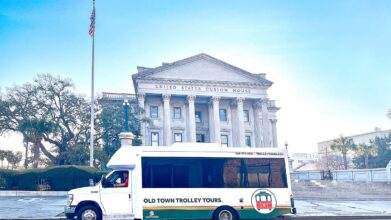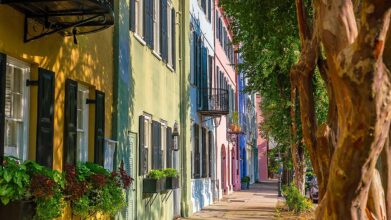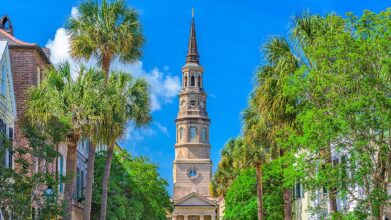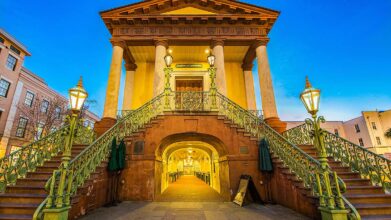Visit Charleston, South Carolina: Architecture and Culture
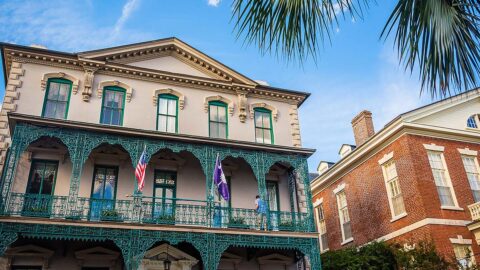
Charleston, South Carolina, is a city steeped in charm, history, and architectural beauty. As you stroll through its cobblestone streets, you’ll find yourself surrounded by historic homes, iconic landmarks, and timeless designs that reflect its centuries-old story. The architecture of Charleston, South Carolina, captures the essence of its cultural evolution. From grand mansions to colorful facades, Charleston is a city that invites visitors to discover the artistry and history embedded in its buildings.
Charleston’s Unique Architectural Heritage
Historical Overview
Founded in 1670, Charleston quickly became a prominent port city in colonial America, attracting trade, culture and architectural inspiration from Europe. Its early success created a thriving environment for craftsmanship and design, which is still evident in the architecture of Charleston, South Carolina. Wealthy merchants and planters built stately homes and civic buildings that showcased both their affluence and the styles of the period. The city’s structures have withstood wars, earthquakes and hurricanes, and its dedication to preserving this architectural legacy ensures that these landmarks remain a testament to its storied past. Preservation efforts, led by initiatives like the Board of Architectural Review, have been instrumental in maintaining Charleston’s character, carefully balancing its historical significance with modern needs.
Architectural Styles in Charleston
 The architecture of Charleston, South Carolina, is defined by its range of classical styles. Georgian architecture, with its symmetrical designs and understated elegance, reflects the city’s colonial roots. During the Federal period, architectural elements became more refined, with intricate moldings and graceful proportions that emphasized sophistication. Greek Revival architecture brought grandeur to Charleston in the 19th century, with its imposing columns and temple-like facades that symbolized strength and permanence. Gothic Revival, often seen in the city’s churches, introduced striking details such as pointed arches and decorative stonework, adding a dramatic element to the skyline. Victorian architecture, with its ornamental features, added character to the city’s residential neighborhoods. These architectural styles are complemented by practical adaptations to Charleston’s subtropical climate. Piazzas, long covered porches that line the sides of homes, allow for cooling breezes to pass through, while shutters provide protection from the elements and enhance the aesthetic of each structure. These elements blend functionality with design, creating homes that are as practical as they are beautiful.
The architecture of Charleston, South Carolina, is defined by its range of classical styles. Georgian architecture, with its symmetrical designs and understated elegance, reflects the city’s colonial roots. During the Federal period, architectural elements became more refined, with intricate moldings and graceful proportions that emphasized sophistication. Greek Revival architecture brought grandeur to Charleston in the 19th century, with its imposing columns and temple-like facades that symbolized strength and permanence. Gothic Revival, often seen in the city’s churches, introduced striking details such as pointed arches and decorative stonework, adding a dramatic element to the skyline. Victorian architecture, with its ornamental features, added character to the city’s residential neighborhoods. These architectural styles are complemented by practical adaptations to Charleston’s subtropical climate. Piazzas, long covered porches that line the sides of homes, allow for cooling breezes to pass through, while shutters provide protection from the elements and enhance the aesthetic of each structure. These elements blend functionality with design, creating homes that are as practical as they are beautiful.
Famous Features
The Charleston Single
A hallmark of the architecture of Charleston, South Carolina, the Charleston single is instantly recognizable. These narrow, multistory homes are designed to maximize airflow and take advantage of the city’s breezes. The piazzas, often located on the long side of the house, serve as shaded outdoor spaces, ideal for enjoying the warm weather. The design of the single house reflects both ingenuity and an appreciation for the environment, making it one of Charleston’s most iconic architectural contributions. Strolling through neighborhoods filled with single houses offers visitors a chance to experience the city’s unique character and thoughtful design up close.
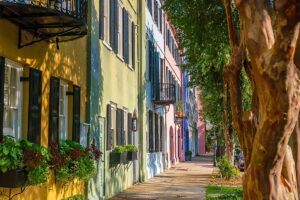 Rainbow Row
Rainbow Row
Rainbow Row, located on East Bay Street, is one of Charleston’s most beloved landmarks. This collection of 13 Georgian row houses is known for its bright, pastel facades, which were restored in the 20th century. The row originally served as the center of Charleston’s commercial district in the 18th century. Today, it stands as a celebration of the city’s commitment to preserving its architectural heritage while adding a playful touch.
Iconic Buildings and Landmarks in Charleston
Charleston, South Carolina, is home to an array of architectural treasures, each offering a glimpse into the city’s rich history and cultural identity and telling a story of resilience, creativity and preservation.
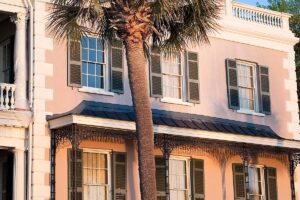 Historic Homes
Historic Homes
Charleston’s historic homes stand as enduring symbols of the city’s legacy, showcasing its architectural evolution and wealth. The Aiken-Rhett House Museum provides a remarkable example of Greek Revival and Federal architecture, preserved in near-original condition. Visitors can explore its extensive grounds, including rare intact slave quarters, offering a window into 19th-century Charleston life. The Nathaniel Russell House, with its iconic free-flying staircase and intricate plasterwork, exemplifies the grandeur of Federal design, while the Edmondston-Alston House offers breathtaking views of Charleston Harbor and houses artifacts from the Civil War era. These homes reflect the architecture of Charleston, South Carolina, and the city’s ongoing commitment to preserving its past for future generations.
For more information and tickets to these houses, please see your Old Town Trolley tour guide or driver.
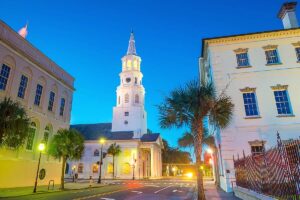 Churches and Religious Architecture
Churches and Religious Architecture
The churches of Charleston represent some of the finest examples of religious architecture in the United States. St. Michael’s Church, the oldest surviving religious structure in Charleston, features a stunning colonial design, complete with a steeple that has stood the test of time. The Circular Congregational Church showcases an unusual yet captivating Romanesque Revival style, setting it apart as one of the city’s architectural gems. Emanuel AME Church, a site of profound historical and cultural significance, remains a powerful reminder of Charleston’s role in the nation’s complex history. These sacred spaces highlight the craftsmanship and vision that define the architecture of Charleston, South Carolina.
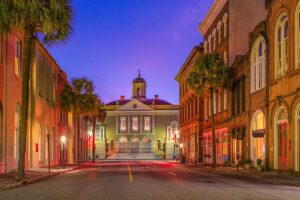 Public and Civic Buildings
Public and Civic Buildings
Charleston’s civic and public buildings provide another layer of architectural depth. Charleston City Hall, built in the early 19th century, is a prime example of Adamesque design, with refined detailing that complements its civic purpose. The Old Exchange and Provost Dungeon, once a center of trade and a British prison during the Revolutionary War, stands as one of the most significant landmarks in Charleston. Its Georgian architecture, coupled with its fascinating history, makes it an essential stop for visitors. These public buildings emphasize the architecture of Charleston, South Carolina, and its ability to merge function with beauty.
 Rainbow Row and The Battery
Rainbow Row and The Battery
Rainbow Row and The Battery are two of Charleston’s most photographed locations, celebrated for their historical and architectural importance. Rainbow Row, a vibrant collection of pastel-painted homes on East Bay Street, symbolizes the city’s restoration efforts and its blend of historical authenticity with visual appeal. Meanwhile, The Battery, a picturesque promenade lined with grand antebellum mansions, overlooks Charleston Harbor and Fort Sumter. These landmarks not only reflect the architecture of Charleston, South Carolina but also embody the city’s enduring charm and historical significance.
The Cultural Influence of Charleston’s Architecture
Impact on Charleston’s Lifestyle
The architecture of Charleston, South Carolina, is deeply intertwined with the city’s lifestyle, shaping how residents and visitors experience its beauty and hospitality. The design of Charleston’s homes often incorporates expansive piazzas and lush gardens, creating inviting spaces for relaxation and socializing. These elements reflect the Southern tradition of hospitality, where homes and public spaces are designed to foster connection and comfort. Public squares and parks, framed by stunning historic buildings, encourage a sense of community and provide a peaceful retreat amid the city’s bustling streets.
Architecture in the Arts
The intricate details of Charleston’s historic homes and landmarks are often featured in paintings and photographs that capture the city’s timeless elegance. Charleston’s architecture has also played a starring role in films and television, providing an atmospheric backdrop that enhances its cultural allure. From best-selling novels to travel documentaries, Charleston’s distinctive style continues to influence and enrich creative works that celebrate its history and beauty.
Architectural Tours and Experiences
Exploring the architecture of Charleston, South Carolina, is a must for visitors who want to immerse themselves in the city’s rich history and cultural heritage. From guided tours to special events, Charleston offers a variety of ways to discover its architectural treasures while learning about the efforts that preserve these landmarks for future generations.
 Old Town Trolley Tours
Old Town Trolley Tours
For a convenient and immersive way to explore the architecture of Charleston, South Carolina, hop aboard Old Town Trolley Tours. This fully narrated tour provides an engaging experience as knowledgeable guides share the stories behind Charleston’s iconic buildings, historic landmarks, and hidden gems. The vehicle offers a unique perspective on Charleston’s architectural evolution, making it an ideal option for families and those looking to cover more ground while learning about the city’s history. With its comfortable ride and expert narration, Old Town Trolley Tours is an essential part of any visit to Charleston.
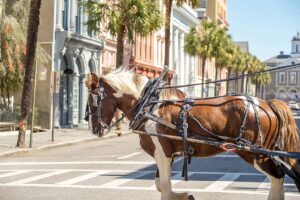 Carriage Rides
Carriage Rides
A horse-drawn carriage ride offers a charming way to see Charleston’s architecture from a different vantage point. With the sound of hooves echoing through cobblestone streets, these tours provide a relaxing journey through the city’s historic districts. Expert guides narrate the history of the buildings and neighborhoods, highlighting how the architecture of Charleston, South Carolina, has evolved over the centuries. Carriage rides offer a blend of comfort and education.
 Special Events: The Charleston Festival
Special Events: The Charleston Festival
One of Charleston’s most celebrated events, The Charleston Festival, provides an exclusive opportunity to explore private homes and gardens that are rarely open to the public. This annual event showcases the city’s architectural brilliance and lush landscapes, offering visitors a chance to appreciate Charleston’s unique design heritage firsthand. The event combines guided tours with cultural activities, allowing participants to connect with the stories behind these historic properties.
Virtual Experiences
For those unable to visit in person, Charleston offers a variety of online resources and virtual tours that bring the city’s architecture to life. From virtual walk-throughs of iconic landmarks to educational videos on preservation efforts, these digital experiences provide an accessible way to learn about the architecture of Charleston, South Carolina. Many local organizations, including the Historic Charleston Foundation, host online events and offer resources that showcase the city’s history and design legacy.
Charleston’s Architectural Preservation Efforts
Preservation has always been at the heart of Charleston’s identity, ensuring that the city’s historic character endures for future generations. Visitors can learn more about the challenges and triumphs of these efforts by engaging with local organizations and supporting initiatives that safeguard Charleston’s architectural heritage.
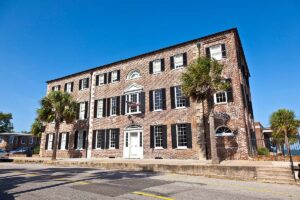 The Role of Preservation Societies
The Role of Preservation Societies
Organizations like the Historic Charleston Foundation play a pivotal role in preserving the city’s iconic buildings and streetscapes. Through advocacy, education, and hands-on restoration projects, these groups ensure that Charleston’s architectural legacy remains intact. Their efforts include maintaining historic homes, conserving public landmarks, and fostering community engagement around preservation.
Challenges in Preservation
Preserving the architecture of Charleston, South Carolina, is not without its challenges. The city must balance modernization and development with the need to maintain its historic character. From combating the effects of climate change and natural disasters to navigating the pressures of urban growth, Charleston’s preservation societies work tirelessly to protect the city’s unique architectural identity while allowing it to thrive in a modern world.
The Importance of Supporting Local Heritage
Visitors can play a significant role in Charleston’s preservation efforts. By participating in architectural tours, attending events like The Charleston Festival or donating to local organizations, visitors contribute to the ongoing protection of the city’s historic charm. Tours such as those offered by Old Town Trolley and walking guides not only provide education but also generate funds that help maintain and restore Charleston’s architectural treasures. Supporting these initiatives ensures that future generations can continue to enjoy the city’s timeless beauty and cultural significance.
Best Times To Experience Charleston’s Architecture and Culture
Charleston, South Carolina, is a city that offers something exceptional throughout the year, but timing your visit can enhance your appreciation of its architectural beauty and cultural richness. The architecture of Charleston, South Carolina, is best explored during the cooler months of spring and fall. In spring, the city comes alive with blooming flowers and mild weather, creating a perfect backdrop for walking tours and sightseeing. Fall offers crisp air and golden light, making it an excellent time to admire the city’s historic homes and landmarks.
Summer, while warmer, is ideal for those who want to enjoy the lush greenery and outdoor festivals that celebrate Charleston’s heritage. Winter provides a quieter atmosphere, with fewer crowds, allowing visitors to explore at a more relaxed pace and appreciate the timeless charm of Charleston’s preserved streets and structures. No matter when you visit, Charleston’s architectural treasures and cultural highlights are sure to captivate.
Seasonal Recommendations
Each season in Charleston brings unique opportunities to experience the city’s history and culture. Spring offers an array of house and garden tours, where visitors can step inside private historic homes and marvel at the architecture of Charleston, South Carolina, firsthand. This is also the season for events like The Charleston Festival, which showcases the city’s design legacy. In summer, outdoor markets and live music along the waterfront provide a lively atmosphere, with Old Town Trolley offering a breezy way to navigate the city without battling the heat on foot.
Fall invites visitors to enjoy cooler temperatures and seasonal events like art walks and cultural festivals. It’s also the perfect time to take a trolley tour through Charleston’s historic districts, where Old Town Trolley’s engaging guides share stories about the people and events that shaped the city’s architectural legacy. In winter, Charleston’s cobblestone streets and iconic landmarks take on a serene quality, providing an ideal setting for those seeking a quieter but equally memorable experience.
Tips for Travel to Charleston
Navigating Charleston is easiest with a combination of walking and convenient transportation options. Old Town Trolley is the perfect way to see the city while learning about the architecture of Charleston, South Carolina, through live narration provided by friendly, knowledgeable guides. The city tour takes you past landmarks such as Rainbow Row, The Battery, and historic churches. For those who prefer a deeper dive into Charleston’s history, guided walking tours focused on specific neighborhoods or architectural styles are readily available.
When planning your trip, book accommodations and activities in advance, particularly during popular seasons like spring and fall. Wear comfortable shoes for walking along Charleston’s cobblestone streets, and don’t forget to bring sunscreen if you’re visiting during warmer months. No trip to Charleston is complete without savoring its culinary offerings, so make time to enjoy Lowcountry cuisine at a restaurant with views of the harbor.
Conclusion
Charleston, South Carolina, stands as a testament to the enduring beauty and significance of historic preservation. The architecture of Charleston, South Carolina, weaves together centuries of design influence, from Georgian and Federal styles to Greek Revival and Gothic Revival masterpieces, all shaped by the city’s climate and cultural evolution. Exploring Charleston means immersing yourself in its rich history and vibrant culture, where every street corner offers a glimpse into the past.
Plan your visit today to discover why Charleston continues to inspire generations of visitors and residents alike. With its unmatched dedication to preservation and its rich architectural legacy, Charleston offers an experience that blends history, design and Southern hospitality in every moment.
FAQs
What architectural styles are most common in Charleston, South Carolina?
Charleston is known for its diverse architectural styles, with Georgian, Federal, Greek Revival, Gothic Revival and Victorian influences prominently featured throughout the city. The architecture of Charleston, South Carolina, reflects the city’s history, from its colonial beginnings to its 19th-century prosperity. Homes like the Charleston single and colorful buildings along Rainbow Row are iconic examples of these styles, blending practicality and beauty in designs adapted to the local climate.
How can I explore Charleston’s hidden courtyards and alleys?
To uncover Charleston’s hidden courtyards and alleys, consider taking a guided walking tour with a focus on the architecture of Charleston, South Carolina. Many tours offer exclusive access to private gardens, charming brick pathways, and tucked-away spaces that are rich in history. Exploring on foot allows you to appreciate the intricate details of wrought-iron gates, cobblestone streets and historic facades that are often missed on larger thoroughfares.
What are some famous landmarks showcasing Charleston’s architecture?
Charleston is home to numerous landmarks that highlight its architectural heritage. Notable sites include the Charleston City Market, St. Michael’s Church, and the Nathaniel Russell House. The Battery, a historic defensive seawall, features grand mansions that showcase Greek Revival and Victorian designs. Each of these locations offers insight into the architecture of Charleston, South Carolina, and the stories behind the city’s most celebrated structures.
What role does Charleston’s architecture play in art and media?
The architecture of Charleston, South Carolina, often serves as inspiration for artists, photographers, and filmmakers. Its iconic structures, cobblestone streets, and charming details provide the perfect backdrop for everything from period dramas to modern art installations. Local galleries frequently feature works inspired by Charleston’s historic buildings, showcasing how the city’s design legacy continues to influence creativity.
What organizations are involved in preserving Charleston’s architecture?
Several organizations are dedicated to preserving Charleston’s architectural heritage. The Historic Charleston Foundation and the Preservation Society of Charleston play key roles in protecting historic homes, landmarks, and neighborhoods. These groups also offer educational programs, tours, and events to promote awareness of the importance of preserving the city’s unique character and history.
Are there any must-visit historic homes in Charleston?
Charleston is home to several historic homes that are open to the public and offer a glimpse into the city’s architectural and cultural past. The Aiken-Rhett House and the Edmondston-Alston House are two notable examples. Both feature original furnishings and architectural details that reflect Charleston’s 19th-century elegance and craftsmanship. Guided tours provide valuable context about the families who lived there and the city’s history during their time.
How old are most of the buildings in Charleston’s historic district?
Many of the buildings in Charleston’s historic district date back to the 18th and 19th centuries. The district is one of the oldest in the United States, with homes, churches and public buildings that have stood for over 200 years. Thanks to ongoing preservation efforts, these structures remain a testament to the city’s enduring legacy and its commitment to maintaining the architecture of Charleston, South Carolina.

